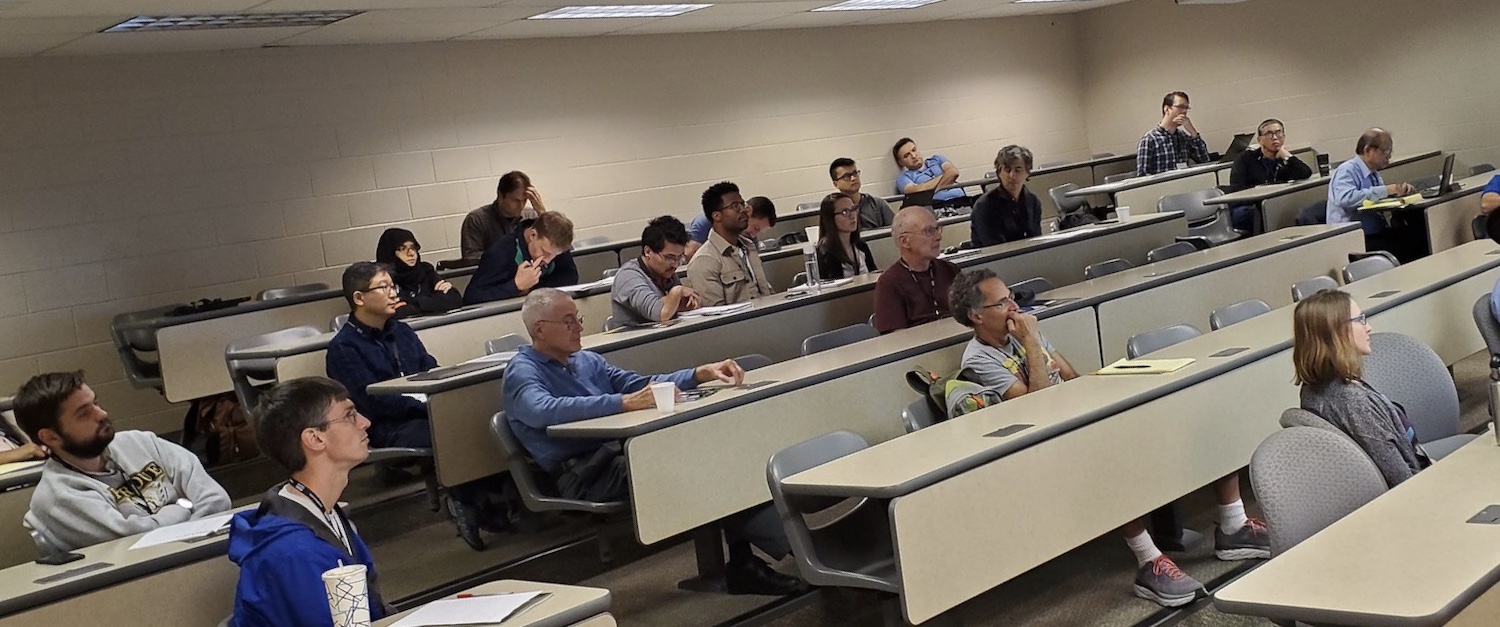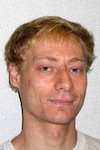Midwestern Workshop on Asymptotic Analysis
Purdue University Fort Wayne, October 4–6th, 2019
General Information

The goal of MWAA is to facilitate interactions between mathematicians from the midwestern United States working in approximation theory, mathematical physics, potential theory, complex analysis by bringing them together in an informal way for a two day workshop. A major objective is to expose attending graduate students to different areas of analysis. We hope these meetings will help to strengthen the partnership and increase the collaboration between analysts in the midwest. We would appreciate if you could help us to disseminate information about the workshop by printing and posting our poster at your department.
 This year workshop is supported by National Science Foundation grants DMS–1936543 and DMS–1745012. It will take place on PFW campus. The talks will be held at Kettler Hall 146, see campus map. Visitors are allowed to park on any parking lot between white lines (spaces between green lines require a permit). The closest lots to Kettler building are Lot 6, Lot 10, and Garage P1 (all indicated on the campus map). Local information page: Analysis Workshop.
This year workshop is supported by National Science Foundation grants DMS–1936543 and DMS–1745012. It will take place on PFW campus. The talks will be held at Kettler Hall 146, see campus map. Visitors are allowed to park on any parking lot between white lines (spaces between green lines require a permit). The closest lots to Kettler building are Lot 6, Lot 10, and Garage P1 (all indicated on the campus map). Local information page: Analysis Workshop.
Accommodation of speakers is arranged by the organizers. All other participants are expected to book their hotel themselves. Nearby hotels include Holiday Inn (walking distance) and Hyatt Place (10 minute drive to campus). There will be a dinner on Saturday night at Factory Restaurant.
The program and the list of submitted abstracts can be found below or here. If you have any further questions, please email the organizers at mwaa@iupui.edu.

More picture from the workshop can be found here.
Organizers

Speakers

Participants

Purdue University Fort Wayne
Syracuse University
University of Wisconsin
IUPUI
IUPUI
Oklahoma State University
University of Toronto
Central Michigan University
IUPUI
Purdue University Fort Wayne
West Liberty University
Texas Tech University
University of Illinois-UC
Case Western Reserve University
Ball State University
University of Michigan
Central Michigan University
Purdue University Fort Wayne
Central Michigan University
Syracuse University
Purdue University Fort Wayne
Indiana University
Oklahoma State University
Purdue University Fort Wayne
University of Michigan
University of Colorado
Purdue University Fort Wayne
Indiana University
Program

Friday

3:30—4:00pm
Coffee

4:00—5:00pm
The theorem that is too good to be true and how it made me very happy
Joint work with Björn Gustafsson
Mergelyan's theorem about approximating continuous functions on compact sets by complex rational functions has often been called a theorem that is too good to be true — but it is! I will describe my 40 year quest to better understand the relationship between the Bergman and Szegő kernels in planar domains and how Mergelyan's theorem helped me check off this thing near the top of my bucket–list.
Saturday

9:00—9:40am
Poster Display and Coffee

09:40—10:20am
Adaptations of an integral form of the maximum principle for nonlinear diffusion equations
A widely used estimate for solutions of diffusion equations is established using a Sobolev–like embedding and a recursive inequality. Of interest on its own, the development and resulting upper bound applies in very general settings. However, this method typically stays in the background, providing a foundation on which further results may be built. Recently, we have applied such an approach (both the method and unfortunately relegating it to the background) toward the study of global solvability for nonlinear diffusion equations with boundary flux driven by memory interactions. We discuss the set up of the integral maximum principle in this context, a resulting local in time maximum estimate, and further adaptation that yields global solvability for the case of degenerate diffusion. In the remaining so-called fast diffusion case, still further modification is needed. On the other hand, the global solvability result for these models turns out to be sharp.

10:30—11:10am
On existence of entire solutions of the Poincaré–Lelong equations in \({\mathbb C}^n\)
Joint work with Yifei Pan
Lelong first studied the Poincaré–Lelong equation \(\sqrt{-1}\partial\bar\partial u = f\), where \(f\) is a \(d\)–closed \((1,1)\)–form defined on \({\mathbb C}^n\), by reducing it to Poisson's equation \(\Delta u = \mathrm{trace}(f)\), assuming suitable growth conditions on \(f\). We prove the existence of entire solutions of the Poincaré–Lelong equations for any \(f\) that is in the weighted Hilbert space with Gaussian measure, i.e., \(L^2_{(1,1)}({\mathbb C}^n, e^{-|z|^2}) \). One of the key ideas is to prove a \(L^2\) version of the Poincaré Lemma for \(2\)–forms, and apply Hörmander's \(L^2\) solutions for Cauchy–Riemann equations.

11:20am—12:00pm
Parabolic measure
We will discuss parabolic measure associated to a uniformly parabolic divergence form operator. We will give a brief overview of some recent results, including a Bourgain–type estimate, a criterion for non-doubling parabolic measure to satisfy a weak reverse Hölder inequality, and that BMO–solvability implies scale invariant quantitative absolute continuity of parabolic measure with respect to surface measure.

12:00—2:00pm
Lunch Break

2:00—2:40pm
Spheres, primes, and triangles: tales from the interface of harmonic analysis and number theory
Pioneered by Bourgain, the fusion of Fourier analytic and number theoretic techniques in novel ways have led to a variety of discrete operator bounds where continuous techniques fail. Moreover, many distributional questions can be answered in a quantitatively strong way by knowing such bounds. We discuss recent work pertaining to distribution of primes on spheres, higher degree spherical maximal functions and three–point configurations.

2:50—3:30pm
The Falconer distance conjecture and Roth’s theorem
Roth's theorem states that a subset of \(\{1,...,N\}\) containing more than \(c N/\log\log N\) elements must contain non–trivial three–term arithmetic progressions. The Falconer distance conjecture asks whether every subset \(E\subset\mathbb{R}^d\), \(d\geq 2\), with Hausdorff dimension greater than \(d/2\) must have a distance set of positive Lebesgue measure. Combining non–trivial techniques from the study of both, joint with Steven Senger we obtain a result on the largeness of certain point configurations within supports of measures whose Fourier transforms lie in \(L^q\) with small enough norm. We motivate the question with a discussion of maximal operators, restriction theorems, and evidence of a deeper connection to arithmetic–combinatorial underpinnings.

3:30—4:00pm
Coffee Break

4:00—4:40pm
Totally asymmetric simple exclusion process
In a traffic flow of cars in a single lane, a slowly moving car affects the following vehicles. The totally asymmetric simple exclusion (TASEP) process is a simple probabilistic model for such a system. It is one of the fundamental models in the interacting particle systems. Furthermore, it is one of the first models for which the law of the fluctuations of the particle locations from their expected locations after a long time is determined. One way to obtain the probability distribution of a particle location is by solving the Kolmogorov forward equation, which is a non–constant coefficient linear PDE, and then taking the large time limit of the Fredholm determinant formula that arises. We discuss how this procedure works for the TASEP on the line and also for the TASEP on a ring which was studied recently.

4:50—5:30pm
Decoupling for real analytic surfaces exhibiting zero curvature
The celebrated \( l^2\) decoupling theorem of Jean Bourgain and Ciprian Demeter presented a new perspective on a range of problems related to hypersurfaces with nonzero Gaussian curvature, such as exponential sum estimates, additive energy estimates, local smoothing, and counting solutions to Diophantine inequalities. The same authors also extended their theory to the \(n\)–dimensional cone. Following their steps, we prove optimal \(l^2\) decoupling results for the remaining class of zero–curvature two–dimensional surfaces (the so–called tangent surfaces). We are also able to prove a decoupling theorem for the real analytic surfaces of revolution. These results should be viewed as partial progress toward the goal of proving a decoupling theorem for arbitrary real analytic hypersurfaces.
Sunday
9:00—10:00am
Poster Display and Coffee

10:00—10:40am
Nontraditional notions of polynomial ordering with computational applications
Nontraditional notions of polynomial degree and ordering will be discussed, with generalizations of several potential-theoretic results proceeding from Siciak–Zaharjuta type theory. I will focus particularly on numerical aspects, and will present generalizations of Fekete and Leja points in this setting, as well as discrete versions of each. I will also present two numerical asymptotic descriptions of the potential theoretic extremal function, generalized to this setting.

10:50—11:30am
An equilibrium problem on the sphere with two equal charges
Joint work with Alan Groot and Arno Kuijlaars
We study the weighted equilibrium measure associated to a logarithmic external field generated by two point charges on the two–dimensional sphere. When the charges are small, the droplet is known to be the complement of two spherical caps, but as soon as the charges become large, the shape of the droplet changes. In this talk we will see how can we describe the shape of the droplet and what is the role of non–standard orthogonal polynomials in the solution of the problem.

11:40am—12:20pm
Optimal recovery of Sobolev classes using multivariate splines
We will start by discussing the general setting of the problem of optimal global recovery of functions from given discrete data. Then we will consider this problem on different classes of multivariate functions and show how multivariate splines arise as exact solutions. If time permits, certain asymptotic results will also be discussed as well as the relation of optimal recovery to certain discrete geometric problems.



